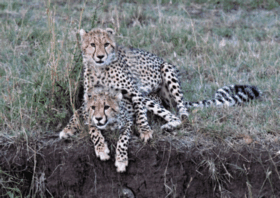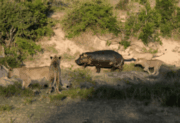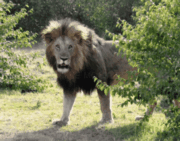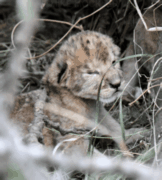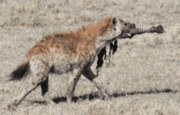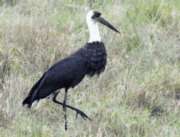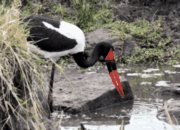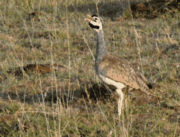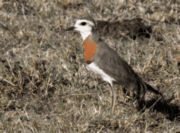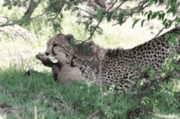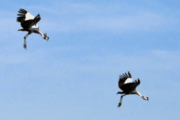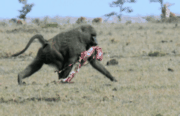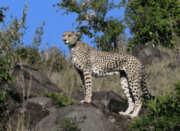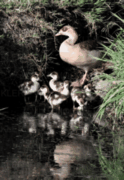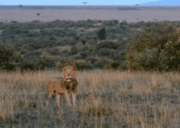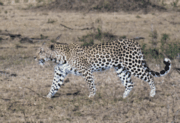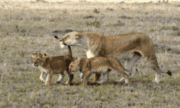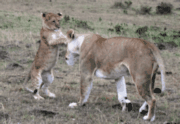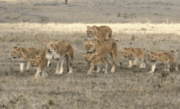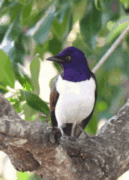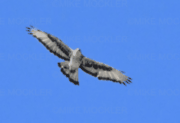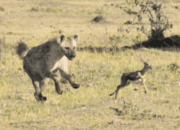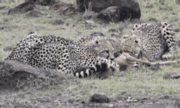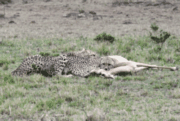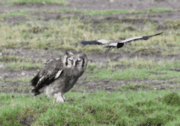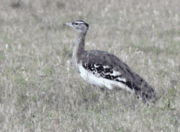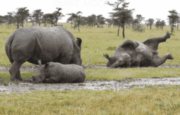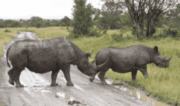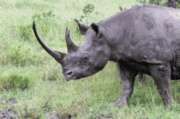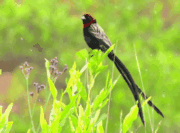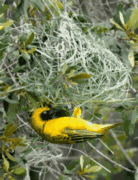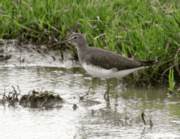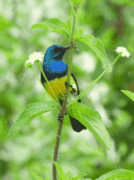Mike Mockler |
KENYA Kenya Private Tour, March 2019 I'm often asked by puzzled acquaintances, "Why do you keep going back to Africa?" They’re even more baffled when I tell them I return to the same locations and camps again and again. "Surely,” they say, “after so many safaris you've seen everything there is to see there!" In fact, nothing could be further from the truth but it’s difficult to convey how excitingly different each safari can be. To illustrate the point, this safari provided numerous unusual sightings and spectacular events. For example, on day 2, we found lions watching a pod of hippos lazing around in a small river. The hippos could see the lions on the riverbank but knew they were safe - as long as they stayed in the water. So, what happened next was very strange: a hippo left the river and ambled around in full view of the lions. Immediately, a sub-adult male lion began to stalk it and was quickly joined by a young lioness. Two more lions were watching with interest. The young male lion leapt on the hippo's back and the lioness grabbed its hindquarters. They lacked the experience of mature lions but the hippo was in real trouble. Somehow it managed to break free from its attackers and ran in panic back to the river where it launched itself from the riverbank and hit the water with a spectacular belly-flop, causing a massive local tsunami. The following day, we were watching another pride of lions feeding on a wildebeest when our excellent Masai guide, Mika, realised his vehicle had a flat battery. The lions were all around us so we had to call the camp on the radio for a new battery to be delivered and installed, not an easy procedure when encircled by a large feline audience. All part of the safari experience and yet another anecdote for the safari sceptics back home. Another memorable event involved a lioness with young. We stumbled upon her with four tiny cubs incredibly well hidden under a fallen acacia tree, deep inside the thorny branches. The cubs were difficult to see but we could tell that their eyes were still closed; they were probably the youngest lion cubs I had ever seen. It was a most unusual place for the mother to have chosen as a den for her babies: the long, sharp thorns were a danger both to her cubs and to herself. There are three lion prides in the Mara North Conservancy (the Acacia, River and Offbeat prides). Unusually, four big males currently control all three of these prides. At night, their deep, far-carrying calls dominate the nocturnal soundscape. Hearing the lions as I lie awake in my tent, I’m spellbound: I still find this the most thrilling sound in Nature. The carcass of a lion kill attracts other predators and scavengers such as spotted hyenas, jackals, vultures, Marabou Storks and even some large eagles that are perfectly happy to scavenge, including Tawny Eagle and the migratory Steppe Eagle. The jackals are quick to see an opportunity to dash in and grab some scraps, while spotted hyenas will take anything they can carry, from the leg of a zebra to a complete rib-cage. March is theoretically the start of the "long rains", even though climate change has made such tidy definitions unreliable. Usually, however, at this time of the year, lush, green landscapes are stunning in the sparkling,clear morning light and, later in the day, dark clouds build up, often producing spectacular sunsets. This is a dramatic time of regeneration when many mammals are accompanied by new-born young, resident birds are resplendent in their colourful breeding plumages and migrant birds in their thousands are passing through on their way back to their northern breeding grounds. Of course, this migration was full of interest to us. Larger migrant species were the easiest to see: European White Stork, Black Stork, Steppe Eagle, Hobby and three species of harrier. Similarly, those travelling in flocks caught our attention: Caspian Plovers, the males sporting attractive new breeding plumages, an apparently endless stream of northbound Barn Swallows, the males rehearsing their cheerful, twittering song and vocal parties of European Bee-Eaters gliding and swooping as they hawked for insects. Smaller migrants passed by unnoticed although more brightly-coloured passerines such as Golden Oriole, Eurasian Roller, Red-backed Shrike, Lesser Grey Shrike and Yellow Wagtail inevitably attracted attention. Northern, Isabelline and Pied Wheatears caught the eye with their flashing white rumps. Modestly-coloured Spotted Flycatchers could easily be overlooked: they had time to linger in the African bush quietly feeding before their long journeys as they would reach their destinations later than most other species. Some northbound Willow Warblers even felt the urge to sing their liquid, cascading song prematurely, a foretaste of pleasures awaiting us after our return to Britain. In addition there were hundreds of resident species to admire including Saddle-billed Stork, Woolly-necked Stork, Red-rumped Swallow, White-bellied Bustard, Rosy-breasted Longclaw, d'Arnaud's Barbet, several cuckoo species and the uncommon Hildebrandt's Francolin, to name just a few. Three years ago, we had spent many hours with a cheetah mother known as Amani (Swahili for "peace") who had two well-grown cubs at that time. Now we had numerous encounters with her and her latest litter of three seven-month-old cubs, two females and a male. On many occasions, we enjoyed the three cubs’ rough and tumble games and occasions when they had delusions of grandeur, chasing much larger animals such as wildebeest and zebras, which usually ran away from the cubs – just to be on the safe side. Elephants, however, were less impressed by young cheetahs with ideas above their station. They turned on them and chased them away amid much loud trumpeting. Such activity alerted all the local prey animals to the cheetahs' presence and made it much more difficult for Amani to hunt. Nevertheless, she did manage to make some kills.One involved her in a long run across extremely rocky terrain to catch a young impala, which the family fed on in the shade of a croton bush. I have written before about the wonderfully confiding elephants in the Mara conservancies and we encountered several groups that displayed this endearing behaviour. The most laid-back was a herd that we found resting, with some of them sleeping flat on the ground, quite unconcerned by our presence. Small calves often lie on the ground to sleep, reassured by the adults in the herd who stand around them, but it’s most unusual to see larger elephants sleeping on the ground, We saw Amani's cubs almost daily and, one morning, witnessed some cheetah behaviour that is rarely seen. In fact, I had observed this only once before on the Serengeti Plains near Ndutu. Two male cheetahs whose range overlapped with Amani's, cornered her and the three cubs. Effectively they held the family prisoners while they checked Amani's suitability for mating. She would not yet be in oestrus - that would happen in a few months, when the three cubs would be separated from their mother - but the two males wanted to make certain.The three youngsters were clearly terrified and Amani placed herself between them and the two males, baring her teeth and spitting fury at her admirers while trying to slash them with her claws. The entire drama was accompanied by an extraordinary cacophony of angry snarling and hissing from all six cheetahs. Two Crowned Cranes that had a nest in the nearby salt-lick took exception to the six cheetahs and dropped down from the sky to see what was going on. They strutted around near the feuding cheetahs complaining loudly. Eventually, the male cheetahs lost interest in Amani and moved away to flop down beneath a tree. The family of four took this opportunity to creep away, nervously looking back over their shoulders to check that the males weren’t following them. Another female cheetah, known as Neema, had very small cubs in a hilly part of the conservancy. She kept them in thick bush high up on a steep, rocky hillside where access was impossible even with 4-wheel-drive. With binoculars we could see the cubs with their mother and were able to photograph her when she left the cubs and came down the hill to hunt. Two years ago, we saw Neema kill a young impala, only to have it stolen and eaten by male baboons. Baboons are partly carnivorous – in fact, we had already seen a male baboon running while clutching the remains of a young Thomson’s gazelle he had caught and killed. Neema has matured since then and this time we saw how cleverly she distracted a bull buffalo that was getting too close to her tiny cubs. Having left the cubs deep inside a croton bush, she walked brazenly past the buffalo, leading him away from where her cubs were hidden. oOo Kenya Group Tour, November 2019 As our light aircraft approached the bush airstrip, it was clear from the air that the Mara conservancies were still dry, though green patches indicated that the “short rains” had begun. Our first game-drives provided a taste of things to come: a huge range of mammals and birds including big numbers of zebras and wildebeest, three groups of lions and herds of elephants. Two fine-looking male cheetahs were watching gazelles, assessing the hunting possibilities but dusk was fast approaching and time soon ran out for them. The following day, we found another younger, male cheetah stalking Thomson's gazelles. Suddenly, he launched his attack. The gazelles raced away in panic with the cheetah at their heels but one gazelle broke away from the fleeing herd and doubled back. For a split second the cheetah was in two minds and hesitated. His inexperience was decisive and the hunt ended in failure. A herd of elephants with young was very relaxed except for a big bull that showed signs of being in musth, making him unpredictable. When he began to show aggression towards us, our excellent Masai guide, Mika, had to drive away very quickly. Night-drives produced bat-eared foxes, genets, white-tailed mongoose, lesser bush babies, five lions and no fewer than three aardwolves. We came across a small leopard cub high in a big tree but it was difficult to get a clear view of it in the dense foliage. Later that day, however, we saw a beautiful, relaxed female leopard known as Tamu and spent over half an hour watching and photographing her. The Acacia Pride was often seen on the nearby plains: four handsome pride males, several lionesses and numerous cubs from three litters that provided endless entertainment with their boisterous play. One morning, the pride females were on the move, accompanied by all their cubs, striding across the plain, watched by scores of nervous herbivores, before finally settling down in the shade. On one game-drive, we came across a spotted hyena relentlessly pursuing a young Tomson's gazelle. With its dogged, rocking-horse motion, the hyena could run for miles without tiring so the fate of the unfortunate gazelle was never in doubt. Most game-drives provided excellent bird sightings. Flocks of Eurasian Bee-Eaters were on passage from the north, along with other migrants such as Yellow Wagtail, Northern, Isabelline and Pied Wheatear, Pallid Harrier and Steppe Eagle. Colourful resident species included Purple Grenadier, Violet-backed Starling, Black-headed Oriole and a photographable Schalow’s Turaco, a glamorous but elusive species that is usually difficult to see, let alone photograph. Nearby, two male ostriches were competing for the attentions of five females: the dominant male finally chased his rival away and mated with one of the females. We frequently found a family of three young cheetahs that had recently separated from their mother, known as Amani. In March, Pat and I had spent many hours with the family of four when the playful cubs were completely dependent on their mother for food. They now had to fend for themselves, a major test for any young cheetahs. However, one dramatic event showed how well Amani had taught them. Soon after leaving camp on an afternoon game-drive, we found ourselves in the middle of a cheetah hunt. The newly independent youngsters chased and pulled down an adult female impala, quite an achievement for such novices. They ate their fill over the following 40 minutes; fortunately for them, no hyenas or lions were nearby to steal their kill. Two days later, we found them killing a young topi they had just caught. As they tucked into their kill, a silver-backed jackal repeatedly edged closer and closer. The young male cheetah found this so annoying he chased the jackal away, though it returned almost immediately. The young topi was insufficient for three growing cheetahs so they made an unsuccessful dash for a dik-dik that had wandered too close, leaving the meagre remains of the young topi for the jackal whose persistence was finally rewarded. We also had regular encounters with the two big male cheetahs that Pat and I had seen intimidating Amani and her frightened youngsters back in March. The following day, at lunch, I heard a vervet monkey in camp giving a predator alarm call. This usually indicates the presence of a spotted cat, often a leopard, so I checked where the monkey was looking. Later, on the afternoon game-drive, we located Nalangu very close to camp. A big thank you to the vervet monkey! To my relief, Nalangu looked fit and well, with no sign of the wounds she had suffered during the lion attack. We stayed with her for some time as she strolled around our vehicle and we left her hidden in a large croton thicket. Goliath Herons are uncommon in this part of Kenya but one was regularly seen near the river in front of camp along with four species of kingfisher. Other birds around camp included Blue Flycatcher, White-browed Robin-Chat, Bronze Mannakin, Yellow Bishop and a pair of Long-Crested Eagles. Out on the nearby plains, we saw a party of migrating White Storks, two Black Storks and a Woolly-necked Stork. Rosy-breasted Longclaws and a White-headed Barbet provided some photo opportunities and a Ruppell’s Long-tailed Starling, bizarrely, was dive-bombed by an aggressive - though much smaller - Striped Kingfisher. A pair of Brown Snake Eagles displayed dramatically on the top of a tree and a Verreaux’s Eagle-owl, resting on the ground at a salt lick, was also dive-bombed, this time by a Spur-winged Lapwing. The placid, confiding elephants of Mara North Conservancy, as always, were a delight to watch. One morning we enjoyed the company of over thirty of them, with several calves. Most were peacefully browsing or
drinking from a pool, while some indulged in sessions of mud-bathing. One very relaxed bull ambled quietly up to our vehicle and calmly looked at us inside. His tusks were only inches away from us but there was no hint of threat. On such occasions, I feel privileged to be so close to these intelligent, sensitive giants. The first two game-drives produced seven black rhinos, five white rhinos, reticulated giraffes, hyena families with pups and rare Jackson’s hartebeests, some with new-born young. Later, we found two handsome cheetah brothers that have been in the area for at least eight years. When I first saw them in 2012, they were in a coalition of three but the third one died two years later. Birdwatching was very productive: Speke’s Weavers, Red-headed Weavers, Chestnut Sparrows and Superb Starling were busy nesting and a Gabar Goshawk was hunting them. The charming, little African Quail-finch was an unusual sighting, as were breeding colonies of Angola Swallows and a pair of Spotted Thick-knees with a small chick. There was also an excellent opportunity to compare two very similar species, Wood Sandpiper and Green Sandpiper, as they obligingly perched close together, side by side. A major highlight was a pair of rare Denham’s Bustards, an attractive species I had seen only a handful of times before. There was fascinating interaction between six white rhinos, including a mother and calf. A large, mature bull was persistently aggressive towards two young bulls while showing great interest in the mother with the calf. She, in turn, showed aggression to all the rhinos, clearly feeling very protective towards her youngster. The highlight was the big bull enjoying a mud-wallow, rolling on his back with his legs in the air. On our final morning, a female black rhino with a large calf came very close to our vehicle. This is normally a shy species but these two individuals were incredibly confiding. Caked in mud, they virtually brushed against our vehicle, enabling us to obtain plenty of close-up photos and video footage. Outside the conservancy, on route to the airstrip to catch our flight to Nairobi, we saw many birds that were new for the trip including Bronze Sunbird, Variable Sunbird, Dusky Flycatcher, White-eyed Slaty-flycatcher and Red-collared Widowbird,. Finally, a big thank you to our excellent guides at the three camps: Mika, Bernard, Benja, David, Saruni, George and the two Peters. Because of their knowledge and expertise, despite the wetter-than-usual November weather, we enjoyed many fabulous wildlife encounters. The old adage “Africa never lets you down” still holds true!
|
|
